What is dongchimi?
Dongchimi (동치미) is a mild water-based kimchi. It’s typically made in late fall with a small variety of white radish called dongchimi mu during kimjang (kimchi making season) and eaten during winter. The word dongchimi means “winter water kimchi”.
Traditionally, dongchimi is made with whole radishes and therefore takes weeks to mature. This recipe is a quick version which is commonly called “summer dongchimi” in Korea.
You cut the radishes into small pieces for quick salting and maturing. Within two days at room temperature in summer, you’ll see bubbles rising through the brine which is a sign of active fermentation.
During fermentation, healthy bacteria, acidity and sweetness develop, producing a tangy, refreshing broth with perfectly pickled radish.
Due to a digestive enzyme (diastase) that is plentiful in radishes, this kimchi promotes digestion, which is why it pairs especially well with meat dishes or starch heavy foods such as rice cakes.
The broth (국물) is great as a soup base for cold noodles like naengmyeon (냉면) and dongchimi guksu (동치미 국수).
How to make dongchimi
For this kimchi, you really need to use Korean radish (mu). See a photo here.
There are three parts to dongchimi – radishes, aromatic vegetables and liquid. The basic method is fairly simple!
First, salt the radishes until they have softened and released some liquid, add the aromatic vegetables such as garlic, ginger, and scallions, and then pour seasoned water over the vegetables. The brine should be slightly too salty to eat as is because the radish will continue to release liquid and dilute the brine.
For this quick summer dongchimi, Korean home cooks typically blend aromatic vegetables to expedite the fermentation process and make the brine become flavorful quicker.
Summer radish has a slight bitter taste, so I used a little bit of sugar in this recipe to balance out the bitterness.
I sometimes also add salted napa cabbages, but it’s optional.
Variations
When I make a large batch of dongchimi, I cut radishes and pears into big chunks, and throw in aromatic vegetables without blending. This is easier but will take longer to ferment. It’s great for making a large batch for longer storage, especially in the fall to last through the winter.
Just make sure you pre-salt the radishes (and napa cabbage if using) and the brine is slightly too salty to eat as is. There’s plenty of water content in radishes that would dilute the brine over time. I sometimes throw in some jujubes (daechu, 대추), and Korean red mustard leaf (gat, 갓), if available.
The good news is that radish season is right around the corner. Soon, you’ll be able to find sweet, juicy, and crunchy Korean radishes, which will be perfect for making dongchimi!
More Korean radish recipes
Kkakdugi (cubed kimchi)
Musaengchae (Spicy radish salad)
Chonggak kimchi (ponytail radish kimchi)
Musaengchae (sweet and sour radish salad)
Muguk (radish soup)
For more Korean cooking inspirations, follow along on YouTube, Pinterest, Twitter, Facebook, and Instagram.
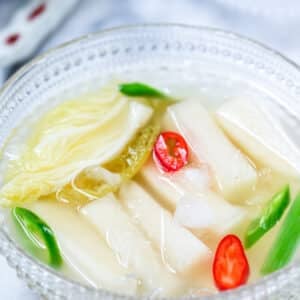
Equipment
- One 1-gallon jar or air-tight non-reactive container.
Ingredients
For the vegetables
- 2 pounds Korean white radish, mu (무)
- 1/2 pound napa cabbage, tender inner parts (or 1/2 pound more radish) See note 1
- 2 green and/or red chili peppers thinly sliced
- 2 scallions cut into about 1-inch lengths
- 3 tablespoons coarse sea salt (divided) Use less (about 25% less) if using small grain salt
- 1 tablespoon sugar (optional if your radish is bitter)
For the brine
- 1/2 Korean pear (or 1 small Asian pear or apple) peeled and cored
- 5 to 7 plump garlic cloves
- 1 inch ginger piece
- 1/4 small onion - optional
- 1 tablespoon glutinous rice powder to make a paste with 1 cup water
- 2 tablespoons salt Use less (about 25% less) if using small grain salt
Instructions
- Clean the radishes by scrubbing with a brush and/or scratching off the impurities with a small knife. Peel the skin only if necessary. The skin is packed with nutrients. Cut each radish crosswise into about 2-inch logs. Then cut each log into 1/2-inch thick pieces and then each piece into 1/2-inch thick sticks, placing in a large bowl.
- Sprinkle about 2 tablespoons of salt and optional 1 tablespoon sugar (use it if your radish is bitter) over the radishes and toss well to coat evenly. Let sit for about 30 - 40 minutes until the radish sticks have softened and released some liquid. Drain, saving the liquid in a bowl or pot you'll be using to make the brine. Do NOT rinse the radish. Place the radish in the jar or kimchi container.
- If using the optional cabbage, rinse the cabbage, and cut each leaf of the cabbage into 2-inch long and 1/2 - 1-inch pieces.
- Dissolve 1 tablespoon of salt in a cup of water and pour over the cabbage. Stir to coat the cabbage pieces with salt water. Let sit for 30 to 40 minutes until softened. Rotate the bottom ones to the top once or twice midway through the process. Drain, saving the liquid in a bowl or pot you'll be using to make the brine. Do NOT rinse the cabbage. Place the cabbage in the jar or kimchi container.
- While the radish is salting, whisk together the glutinous rice powder and 1 cup of water, and simmer over low heat, stirring occasionally, until the mixture thickens into a thin paste. Set aside to cool it.
- Place the pear (or apple), garlic, ginger and optional onion in the blender. Add 1/2 cup water. Puree it as fine as possible. Run it through a fine strainer to remove leftover solids for cleaner broth, if desired.
- To make the brine, add about 9 cups of water to the reserved liquid from salting the radish and cabbage. Add the aromatic vegetable puree and glutinous rice paste. Stir in salt, starting with a tablespoon. Stir well to dissolve the salt, and taste it before adding more salt.
- Place the salted radish and cabbage in a jar or air-tight container. Add the scallion and peppers. Pour the brine over. Stir well together. Taste the brine. Add more salt if necessary. If the brine is too salty, add more water to dilute. It should be a tad salty to eat as is.
- Leave it out at room temperature for a full day or two until bubbles rise through the brine. Taste again and add more salt if necessary or add more water if too salty. Then, store in the fridge. Although you can start eating it any time at this point, it will need about a week or two in the fridge to fully develop the acidic, tangy flavors. It keeps well for several weeks in the fridge. Stir from the bottom each time you ladle the broth from the jar or container to serve.
Notes
- Make baechu guk with the leftover cabbage. If omitting, use 1/2 pound more radish.
- VARIATION: You can also make dongchimi by cutting radishes and pears into big chunks and throwing in aromatic vegetables without blending. This is easier but will take longer to ferment. It's great for making a large batch for longer storage. Be sure to pre-salt the radishes (and napa cabbage if using). The brine should be slightly too salty to eat as is. There's plenty of water content in radishes that would dilute the brine over time. I sometimes throw in some jujubes (daechu, 대추), and Korean red mustard leaf (gat, 갓), if available.
This recipe was originally posted in September 2012. Here, I have updated it with new photos, more information and minor changes to the recipe.


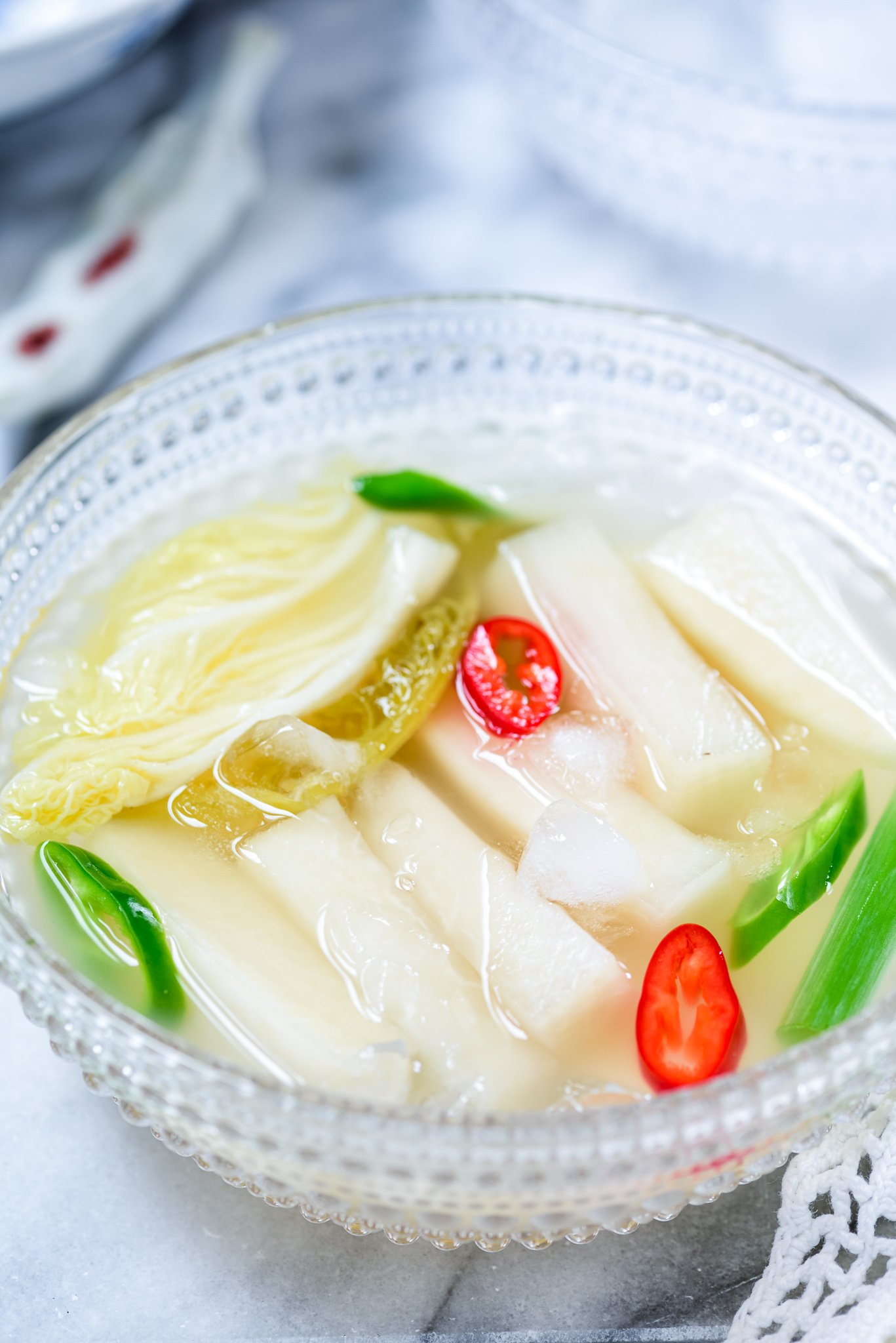
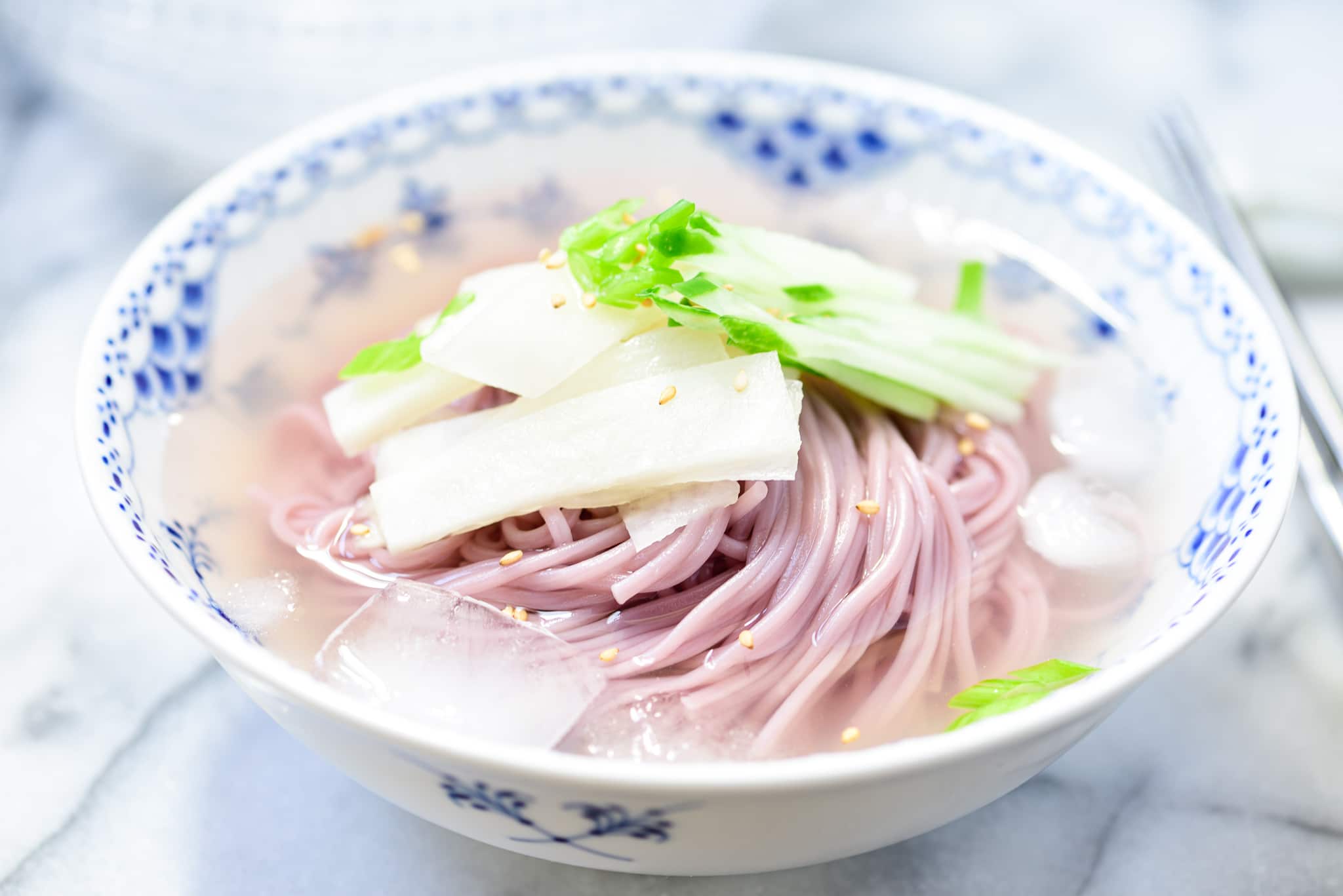
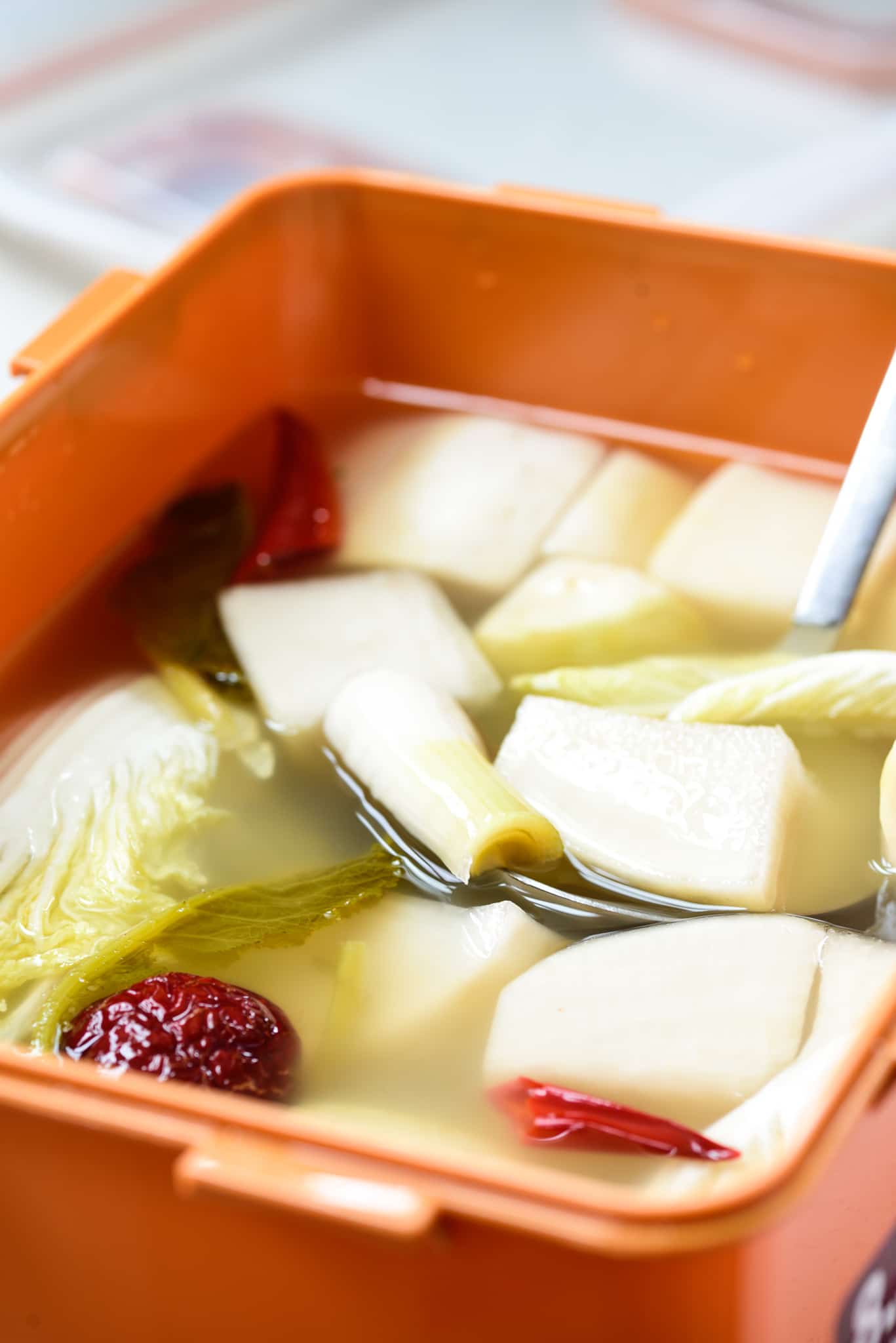
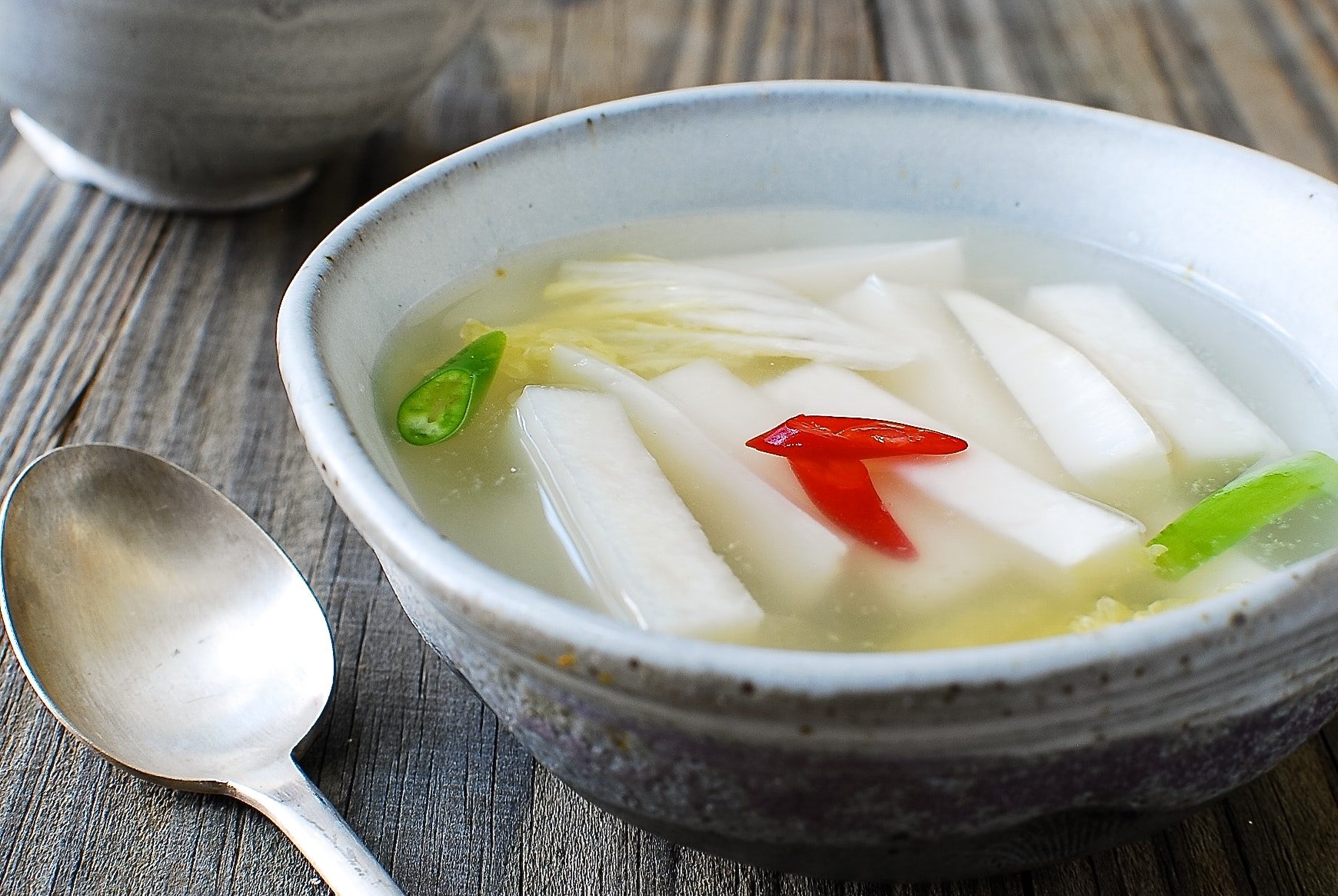
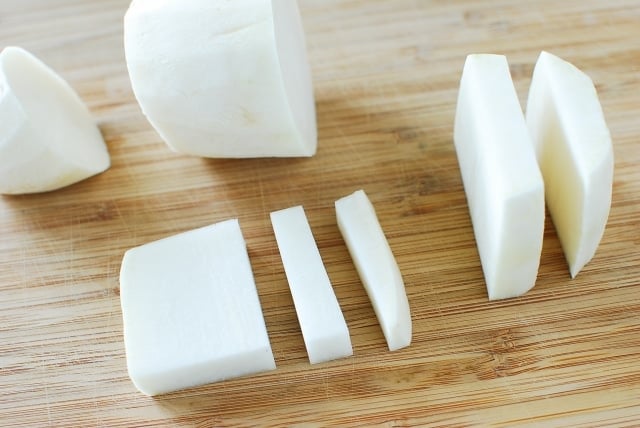
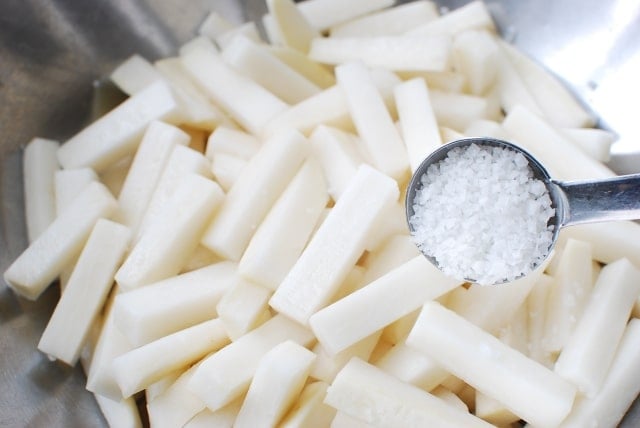
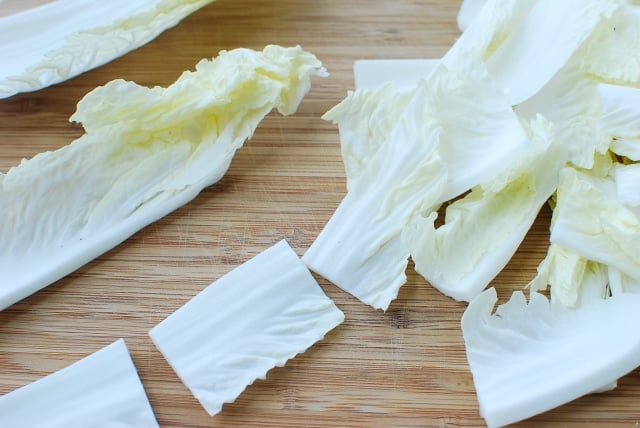
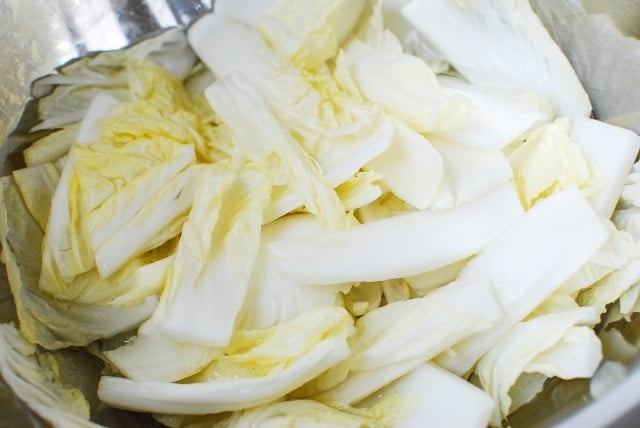
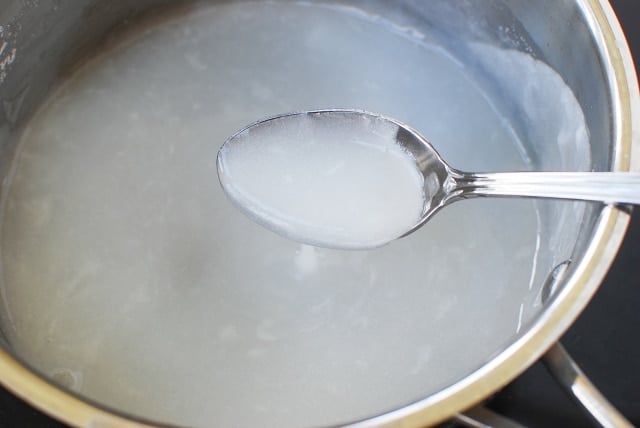
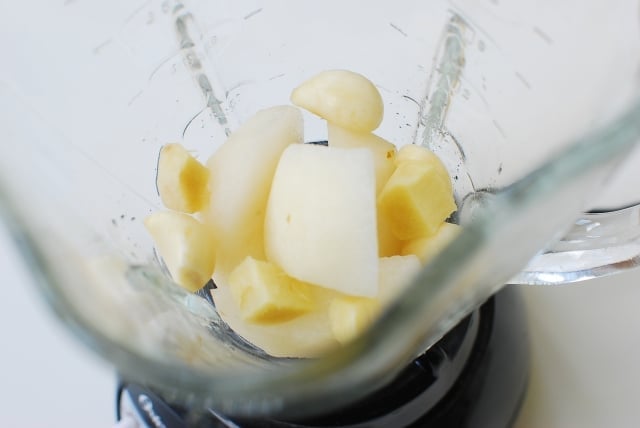
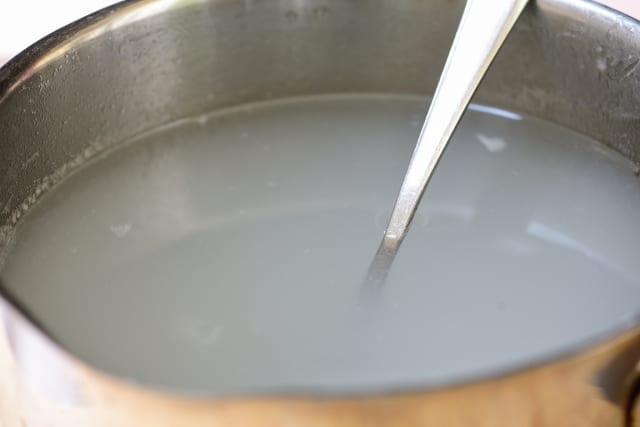
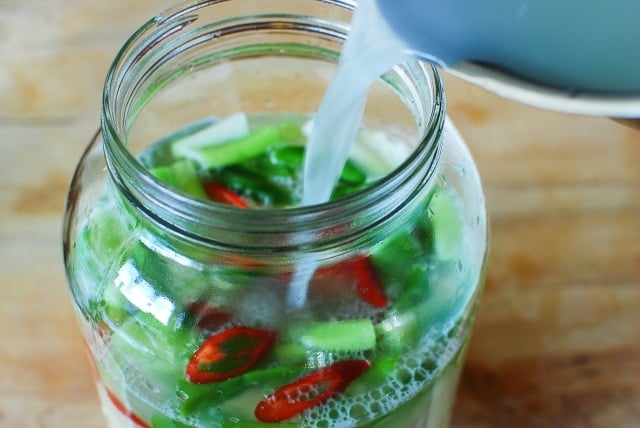
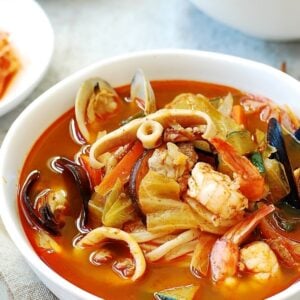
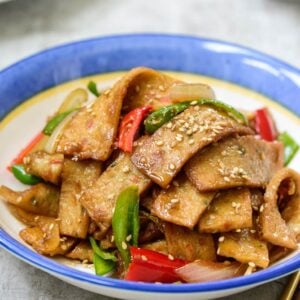
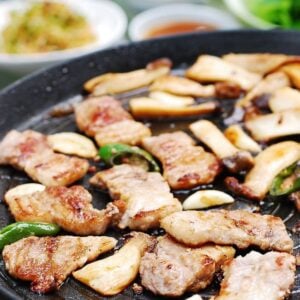


















Grace says
How much brine will this recipe make? I’m hoping to make your naengmyeun recipe but wanted to know if I need to make the full batch of dongchimi (with 2 lbs of mu) to make 4 servings of the cold noodle soup. Thank you.
CS says
Thank you! I see a lot of recipes that use 2-3 TB maesilcheong in dongchimi. Do you know if maesilcheong has trace alcohol? The one I use is 55% plum and 45% sugar.
Hyosun says
No it doesn’t. Just adds sweetness and acidity.
Helen says
I just tried this recipe but with larger chunks of radish & didn’t puree the aromatics. The liquid is kind of cloudy. Is that ok? Also if I find it isn’t salty enough can I add more now?
Or is it too late? I made it 3 days ago.
I’m always cooking your recipes!
Thank you!
Eve says
Thank you for the recipe! I was wondering what jars you used since they seem to be the perfect size and I don’t have any (and was thinking of buying some). Do you remember where you got them?
Hyosun says
Korean markets around here carry them, but you can also find them on Amazon. There are half gallon ones and one gallon ones.
Mitchell says
Hello,
I love your recipes and I am trying out your dongchimi recipe. I left it out for 2 days and a half and I noticed some of the radishes are turning slightly pink. Is this bad?
Christine says
This turned out so well! My partner and I ate up most of the kimchi and now have a lot of brine left – feels like a waste to throw it away. Do you use the leftover brine for any recipes?
Toran says
Mix half dongchimi brine with half brisket broth for the most amazing naeng myun !!
Jason says
It’s a bit late to reply to your question, but hopefully this will help others with the same question. You can drink the brine straight from the jar (ladled into a cup or bowl, of course.) It’s very refreshing right out of the fridge and if fermented properly, will have a very slight fizz that will quench your thirst. The brine is a bit salty, a bit sour, and chock full of probiotics. I like to have a bowl of dongchimi while eating marinaded ribs or pork belly. Anything fatty, really. The brine really cuts through the fat and refreshes the palate.
sooch says
Hi Hyosun,
Is it possible to make it without garlic? I tried it and everything is good except that it makes my fridge smell very strongly of garlic.
Hyosun says
Of course. Leave it out if you don’t like the smell.
Carissa says
If my brine is too salty can I just add more water to fix it? Or can I wait to add water when I serve it? Thanks in advance!
Hyosun says
You can add water now.
DS says
Definitely appreciate your recipes but really wish there was a button to put them into a printable format. It’s quite difficult to keep reading my PC at the same time I’m in the kitchen cooking. To cut the photos and excess and put onto one page is really convenient for home cooks.
Hyosun says
I’ve been doing that for a while with new recipes and converting the older ones. But, I know I still have a lot of older recipes to get to. Sorry about the inconvenience.
sunny kang says
Hi,
I made dongchimi, but after 1 day of being in room temperature, it is bubbling but the brine is quite thick and slimy. It smells fine and tastes good, but not sure why the brine is so thick and slimy. Otherwise smells fine. Will it clear out as fermentation process continues? Thanks. For now I just put in fridge to slow down the fermentation process.
sunny
Hyosun says
It could be the scallions that have extra slimy stuff in the green tubes. Sometimes sugar does that. It should be fine to eat. You did the right thing. I will get clear up some as it ferments.
Joanna says
I’ve had this recipe bookmarked for a while and finally made it the other day!! It’s been so hot in NY, so wanted to make something refreshing. This was so easy I can’t believe I didn’t make it sooner!! Thanks so much for the recipe!! I can’t wait to impress my in laws with this!
Mion Chia says
Hi if i can’t get korean radish is it ok to use daikon?
Hyosun says
Yes, you can.
Tim says
Hi I read a recipe which uses cheese cloth versus purée. What is the difference between the two methods?
Hyosun says
So sorry about the late reply. I somehow missed your comment at the time. The use of cheese cloth will result in cleaner broth without tiny bits of pureed aromatic vegetables. It’s a matter of preference.
Jay says
Hi! Can you tell me why lot of kimchi recipes requires “glutenous flour” paste? What does it exactly do to kimchi? What happens if I omit it? What kind of kimchi doesn’t require the glutenous paste? Thank you!!!
Hyosun says
It’s used in kimchi for various reasons depending on what type of kimchi it is. In general, it’s used to thicken the kimchi seasoning or brine and add natural sweetness from the grain, which helps bring the flavors together. Sometimes, it’s used to help rid of grassy taste from certain green vegetables such as young radish leaves (yeolmu). It’s also used to help promote the fermentation process. You can omit it if you want from any kimchi. It’s a common ingredient, but certainly not the must-have.
dorthyporthy says
I made this a few weeks ago and it turned out great! Super easy, super delicious. It’s one of my favorite kinds of kimchi, so thank you for this recipe!
Hyosun Ro says
So happy to hear that! Thanks for letting me know. Cheers!
Anonymous says
hi Hyosun, thanks for posting this recipe, I’m going to give this a go. Last time I made it, after about 2-3 weeks the brine turned a bit grey & slimy and the radish didn’t taste too good. Almost likely mouldy, is that suppose to happen? Thanks as always for your recipes! Joyce
Hyosun Ro says
That doesn’t sound good. Maybe you didn’t use enough salt? The fall/winter radish is good, so it’s good time to make this now. Hope my recipe will work better for you. I’ve heard from some of my readers that this turned out delicious for them. Cheers!
Katerina says
This kimchi looks so comforting and tasty! A totally different dish from the ones we make here in Greece!
Hyosun Ro says
Thank you, Katerina. I’m now curious about the ones made in Greece.
Nami | Just One Cookbook says
This looks like my kind of kimchi! How interesting to see Asian pear in this recipe as well (not just the BBQ sauce). I love radish and I can pick on this dish as long as it is in front of me! Could finish whole jar myself.. 🙂
Hyosun Ro says
You’re right, Nami. This kimchi is perfect for people who don’t like spicy food. Pear is commonly used in kimchi. Thanks for stopping by!
Shelly says
Hi, I am new to Korean cooking and have become a fan of persimmons and shingo pears. Trader Joe’s is now selling dried Korean shingo pears. They taste good on their own but I’m thinking they would be great in a cake or pastry. Do you have any recipes you could share using shingo pears? Thank you!!
Hyosun Ro says
Dried Korean pears at Trader Joe’s? That sounds great. I have to think about this. Will let you know if I come up with any good idea.